- Pensar Academy
- Wellness Policy
Wellness Policy
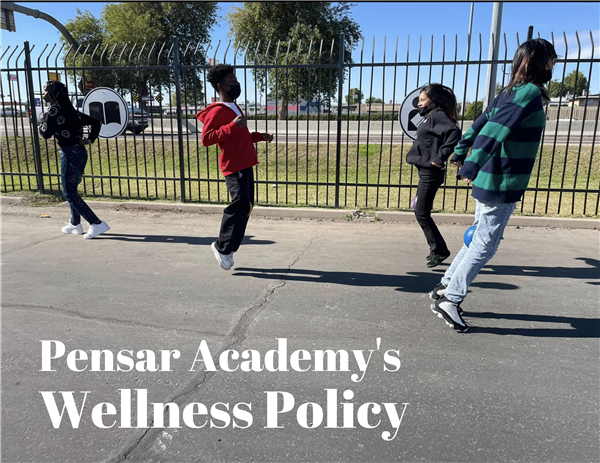
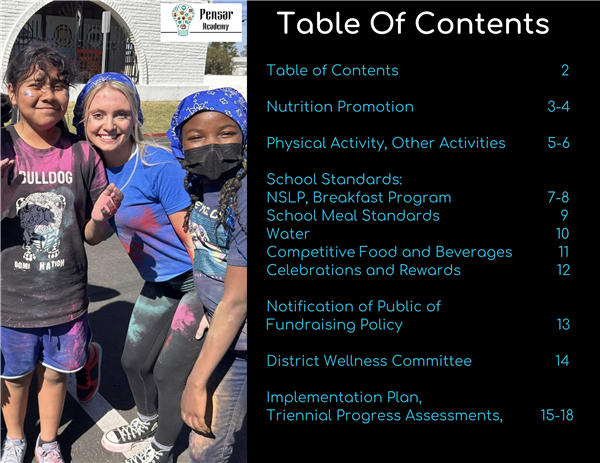
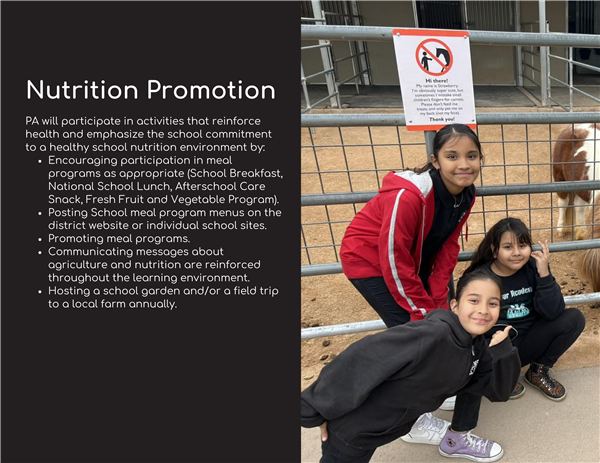

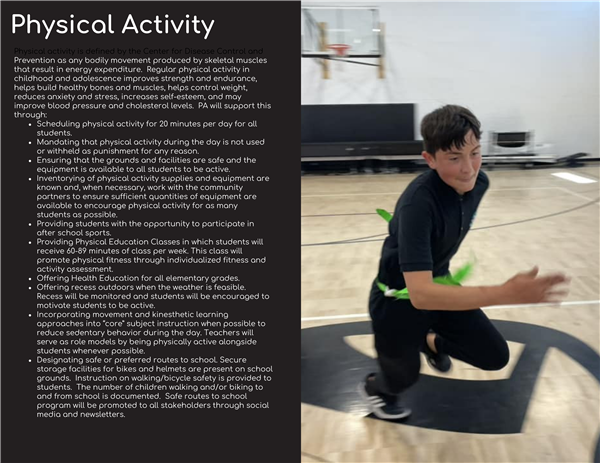

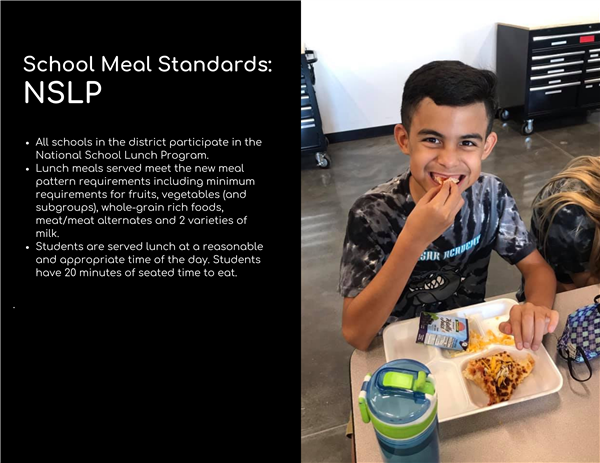
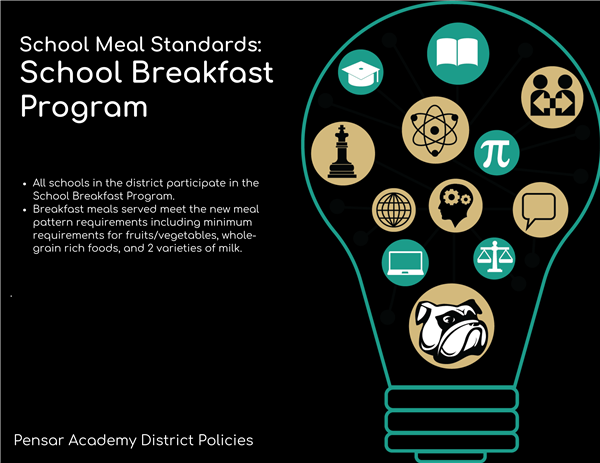
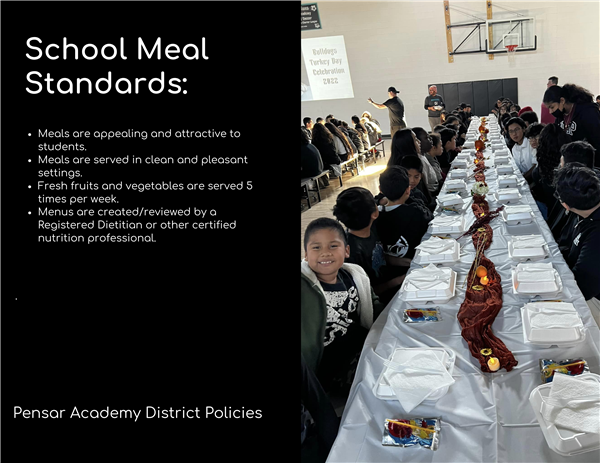
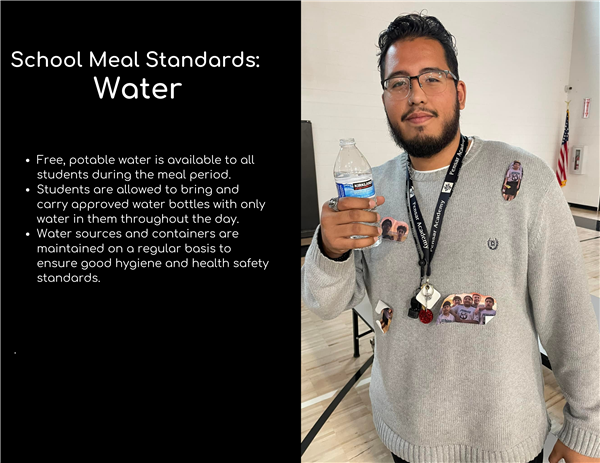
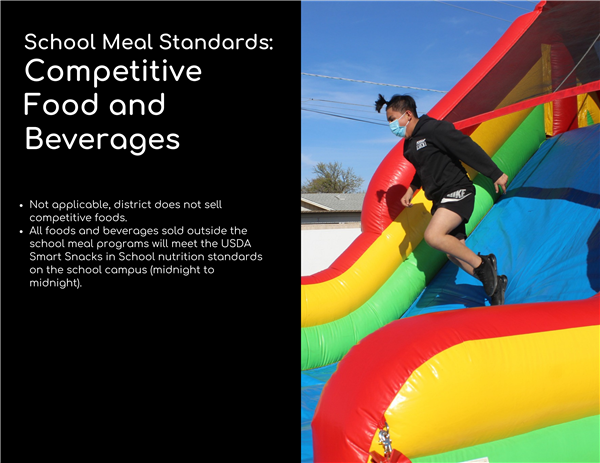
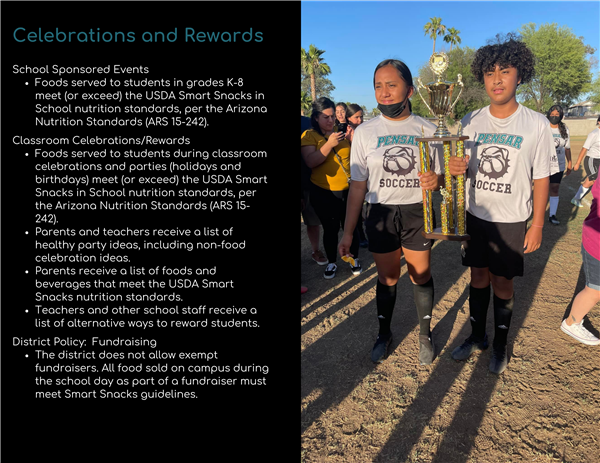
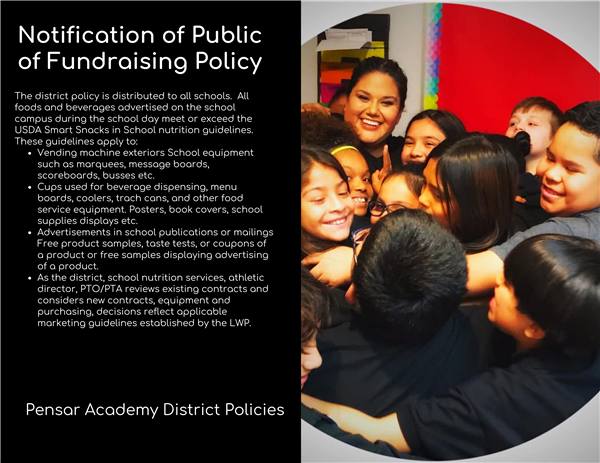
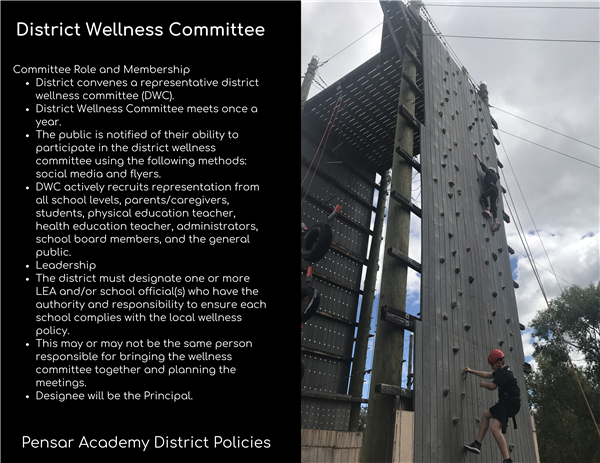
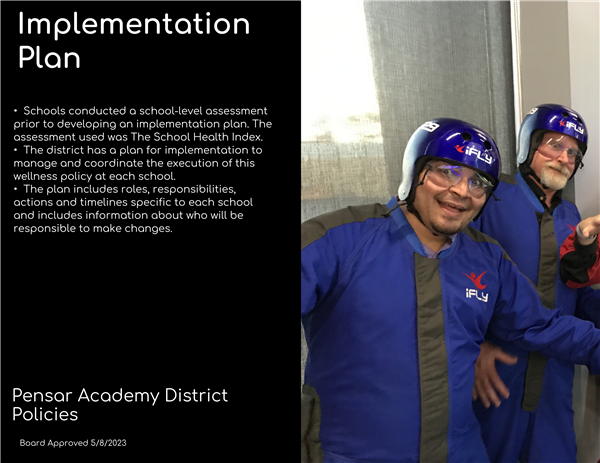
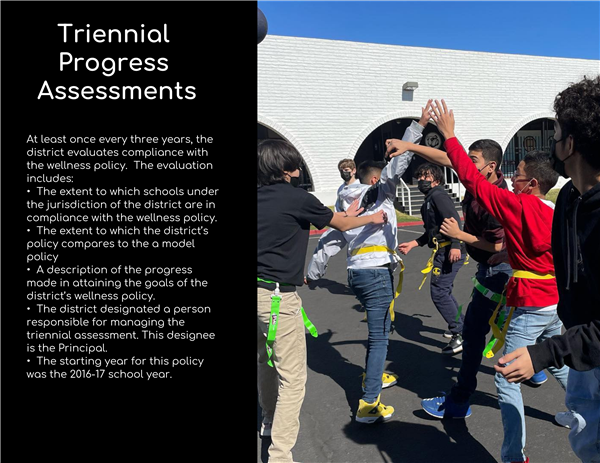

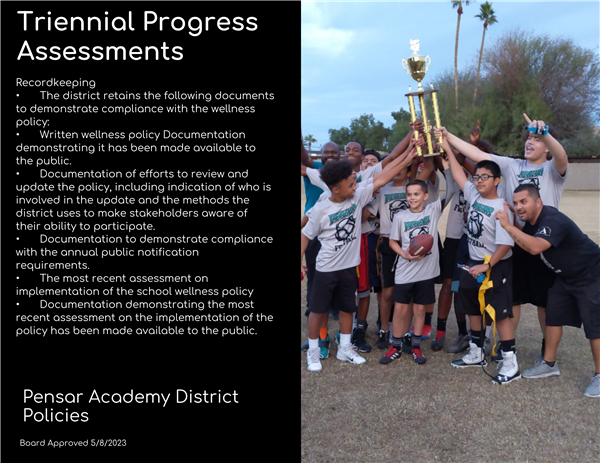
-
-
Wellness Goals:
- Nutrition Promotion: PA will participate in activities that reinforce health and emphasize the school commitment to a healthy school nutrition environment by:
- Encouraging participation in meal programs as appropriate (School Breakfast, National School Lunch, Afterschool Care Snack, Fresh Fruit and Vegetable Program).
- Posting School meal program menus on the district website or individual school sites.
- Promoting meal programs.
- Communicating messages about agriculture and nutrition are reinforced throughout the learning environment.
- Hosting a school garden and/or a field trip to a local farm annually.
- Nutrition Education: PA will participate in teaching behavior-focused skills offered as a part of a comprehensive, standards based program to provide students with the knowledge and skills to safeguard their health and make positive choices regarding food and nutrition by:
- Teaching nutrition education in grades 4-8. Nutrition education is included in the health education lessons and the following topics will be covered:
- Relationship between healthy eating and personal health and disease prevention.
- Food guidance from MyPlate.
- Reading and using the FDA’s nutrition fact labels.
- Eating a variety of foods every day.
- Choosing foods and beverages with little added sugar.
- Eating more calcium rich foods.
- Food safety.
- Importance of water consumption.
- Importance of eating breakfast.
- Making healthy choices when eating at restaurants.
- Develop a plan and track progress toward achieving a personal goal to eat healthfully.
Nutrition education will include hands-on learning experiences:
- Cooking demonstrations
- Taste testing
- School gardens
- Farm tours
- Physical Activity: Physical activity is defined by the Center for Disease Control and Prevention as any bodily movement produced by skeletal muscles that result in energy expenditure. Regular physical activity in childhood and adolescence improves strength and endurance, helps build healthy bones and muscles, helps control weight, reduces anxiety and stress, increases self-esteem, and may improve blood pressure and cholesterol levels. PA will support this through:
- Scheduling physical activity for 20 minutes per day for all students.
- Mandating that physical activity during the day is not used or withheld as punishment for any reason.
- Ensuring that the grounds and facilities are safe and the equipment is available to all students to be active.
- Inventorying of physical activity supplies and equipment are known and, when necessary, work with the community partners to ensure sufficient quantities of equipment are available to encourage physical activity for as many students as possible.
- Providing students with the opportunity to participate in after school sports.
- Providing Physical Education Classes in which students will receive 60-89 minutes of class per week. This class will promote physical fitness through individualized fitness and activity assessment.
- Offering Health Education for all elementary grades.
- Offering recess outdoors when the weather is feasible. Recess will be monitored and students will be encouraged to motivate students to be active.
- Incorporating movement and kinesthetic learning approaches into “core” subject instruction when possible to reduce sedentary behavior during the day. Teachers will serve as role models by being physically active alongside students whenever possible.
- Designating safe or preferred routes to school. Secure storage facilities for bikes and helmets are present on school grounds. Instruction on walking/bicycle safety is provided to students. The number of children walking and/or biking to and from school is documented. Safe routes to school program will be promoted to all stakeholders through social media and newsletters.
- Other Activities That Promote Wellness:
- School Sponsored Events: PA will incorporate wellness components including physical activity and healthy eating opportunities.
- Relationships with Community Partnerships:
- Local businesses
- Universities and colleges
- Community Health Promotion and Family Engagement: Families are informed and invited to participate in school-sponsored activities and receive information about health promotion efforts.
- Staff Wellness and Health Promotion: PA promotes staff member participation in health promotion programs.
District Policies
- School Meals Standards:
- National School Lunch Program
- All schools in the district participate in the National School Lunch Program.
- Lunch meals served meet the new meal pattern requirements including minimum requirements for fruits, vegetables (and subgroups), whole-grain rich foods, meat/meat alternates and 2 varieties of milk.
- Students are served lunch at a reasonable and appropriate time of the day. Students have 20 minutes of seated time to eat.
- School Breakfast Program
- All schools in the district participate in the School Breakfast Program.
- Breakfast meals served meet the new meal pattern requirements including minimum requirements for fruits/vegetables, whole-grain rich foods, and 2 varieties of milk.
- School Meal Standards
- Meals are appealing and attractive to students.
- Meals are served in clean and pleasant settings.
- Fresh fruits and vegetables are served 5 times per week.
- Menus are created/reviewed by a Registered Dietitian or other certified nutrition professional.
- Water
- Free, potable water is available to all students during the meal period.
- Students are allowed to bring and carry approved water bottles with only water in them throughout the day.
- Water sources and containers are maintained on a regular basis to ensure good hygiene and health safety standards.
- District Policy: Competitive Food and Beverages
- Not applicable, district does not sell competitive foods.
- All foods and beverages sold outside the school meal programs will meet the USDA Smart Snacks in School nutrition standards on the school campus (midnight to midnight).
- District Policy: Celebrations and Rewards
- School Sponsored Events
- Foods served to students in grades K-8 meet (or exceed) the USDA Smart Snacks in School nutrition standards, per the Arizona Nutrition Standards (ARS 15-242).
- Classroom Celebrations/Rewards
- Foods served to students during classroom celebrations and parties (holidays and birthdays) meet (or exceed) the USDA Smart Snacks in School nutrition standards, per the Arizona Nutrition Standards (ARS 15-242).
- Parents and teachers receive a list of healthy party ideas, including non-food celebration ideas.
- Parents receive a list of foods and beverages that meet the USDA Smart Snacks nutrition standards.
- Teachers and other school staff receive a list of alternative ways to reward students.
- District Policy: Fundraising
- The district does not allow exempt fundraisers. All food sold on campus during the school day as part of a fundraiser must meet Smart Snacks guidelines.
Notifying Public of Fundraising Policy
- The district policy is distributed to all schools.
- District Policy: Food and Beverage Marketing
- All foods and beverages advertised on the school campus during the school day meet or exceed the USDA Smart Snacks in School nutrition guidelines. These guidelines apply to:
- Vending machine exteriors School equipment such as marquees, message boards, scoreboards, busses etc.
- Cups used for beverage dispensing, menu boards, coolers, trach cans, and other food service equipment. Posters, book covers, school supplies displays etc.
- Advertisements in school publications or mailings Free product samples, taste tests, or coupons of a product or free samples displaying advertising of a product.
- As the district, school nutrition services, athletic director, PTO/PTA reviews existing contracts and considers new contracts, equipment and purchasing, decisions reflect applicable marketing guidelines established by the LWP.
District Wellness Committee
- Committee Role and Membership
- District convenes a representative district wellness committee (DWC).
- District Wellness Committee meets once a year.
- The public is notified of their ability to participate in the district wellness committee using the following methods: social media and flyers.
- DWC actively recruits representation from all school levels, parents/caregivers, students, physical education teacher, health education teacher, administrators, school board members, and the general public.
- Leadership
- The district must designate one or more LEA and/or school official(s) who have the authority and responsibility to ensure each school complies with the local wellness policy.
- This may or may not be the same person responsible for bringing the wellness committee together and planning the meetings.
- Designee will be the Principal.
Implementation Plan:
- Implementation Plan
- Schools conducted a school-level assessment prior to developing an implementation plan. The assessment used was The School Health Index.
- The district has a plan for implementation to manage and coordinate the execution of this wellness policy at each school.
- The plan includes roles, responsibilities, actions and timelines specific to each school and includes information about who will be responsible to make changes.
- Triennial Progress Assessments
- At least once every three years, the district evaluates compliance with the wellness policy.
- The evaluation includes:
- The extent to which schools under the jurisdiction of the district are in compliance with the wellness policy.
- The extent to which the district’s policy compares to the a model policy
- A description of the progress made in attaining the goals of the district’s wellness policy.
- The district designated a person responsible for managing the triennial assessment. This designee is the Principal.
- The starting year for this policy was the 2016-17 school year.
- Revisions and Updating the Policy: Policy will be updated when appropriate, including when wellness goals are met and new state or federal guidelines are issued.
- Notification of Wellness Policy, Policy Updates, and Triennials Assessments:
- The public has access to the LWP at all times on the district webpage.
- District informs families and the public each year of basic information about the policy, including its content, updates, and implementation status.
- Best practice is to include last revision date on LWP.
- District informs families and the public each year of basic information about the policy, including its content, updates, and implementation status through social media and sending information home.
- The district will actively notify households of the availability of the triennial progress report.
- The triennials assessments are available to the public at the school website at pensaracademy.org.
- Recordkeeping
- The district retains the following documents to demonstrate compliance with the wellness policy:
- Written wellness policy Documentation demonstrating it has been made available to the public.
- Documentation of efforts to review and update the policy, including indication of who is involved in the update and the methods the district uses to make stakeholders aware of their ability to participate.
- Documentation to demonstrate compliance with the annual public notification requirements.
- The most recent assessment on implementation of the school wellness policy
- Documentation demonstrating the most recent assessment on the implementation of the policy has been made available to the public.
-

